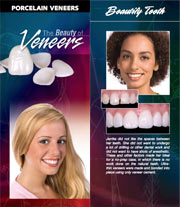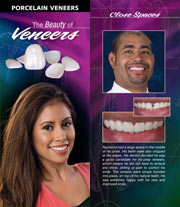I Don't Like the Look of My Teeth
Have you ever found yourself thinking, “I don’t like the look of my teeth” or “I don’t have the smile I want”? Most of us have. Our teeth can become discolored, chipped, cracked or even rotten through the rigors of normal daily use. Undoubtedly you have been told that you should brush and floss daily, as well as visit your dentist at least every six months – but what is your option if, like most people, you haven’t taken the best care of your teeth or if you can’t even remember the last time you visited a dentist?
Well, it’s never too late to start. With the help of your restorative dentist, your smile can become picture perfect! These professionals give your smile a beautiful look and strong, comfortable functionality, even if you never had either in the first place. In some cases, it could even take as little as a single appointment!
Restorative Dentistry
Restorative dentistry is the field of dentistry that focuses on the rehabilitation and restoration of the teeth and gum tissue to desired function and esthetics. A major focus of restorative dentistry is saving the patient’s existing tooth structure in some way, rather than simply removing the tooth in its entirety and replacing it with a man-made substitute. In the United States, restorative dentistry is not an American Dental Association defined specialty; dentists who perform these types of procedures are just classified as general dentists. However, these professionals have attended and graduated from at least four years of dental school as well as passed a rigorous national written exam and a regional clinical licensing exam in order to practice dentistry. Restorative dentists who wish to further their specialization can attend advanced training to become endodontists, periodontists and prosthodontists.
Restorative Options
While treatment options for a patient are ultimately up to the expertise of the dentist, there are several common solutions that can restore a smile. A dentist may provide you with a variety of treatments, such as placing veneers, crowns or a bridge. These solutions are called restorations, which are man-made tooth substitutes that replace or cover your existing tooth. You might think you need an orthodontist to fix gaps and crooked teeth; however, a restorative dentist can use a combination of reduction techniques and the placement of restorations to make teeth straight. That’s right — not every patient needs years of wires and brackets to fix their smile!
BruxZir® Solid Zirconia Crowns & Bridges
A common solution to fixing a patient’s tooth is placing a restoration, such as a crown or bridge. A crown is a tooth-shaped restoration that slips over the patient’s prepared tooth and is secured in place with cementing chemicals. Crowns can be made from precious metals or ceramic materials, or most traditionally a combination of both. Modern crowns match natural teeth in color and appearance, making it difficult for people viewing your smile to know that you have a replacement tooth.
Bridges are very similar to crowns, except they serve an additional purpose. Bridges replace missing gaps in your arch. To fix a gap created by a lost tooth, a dentist will reduce the teeth on both sides of the gap and then place a bridge that connects the two teeth and the in-between space as one unit. Essentially, a bridge is a replacement tooth that fills in an empty space while being structurally connected to at least one additional tooth for support.
BruxZir® Solid Zirconia is a highly esthetic, strong material that can be used to create crowns and bridges. It is the most prescribed brand of full-contour zirconia, and has a proven record of success in patients around the world.
Brochures
Download PDF brochures to view the benefits of choosing BruxZir Solid Zirconia Crowns & Bridges. You must have Adobe Acrobat Reader to view this file type.
Porcelain Veneers
A less invasive solution, veneers are thin, shell-like structures that cover the front side of teeth. Made from tooth-colored materials, veneers are permanently bonded to the patient’s tooth in an effort to provide a more natural looking tooth. They cover up stains, cracks and decay while also protecting the remaining natural tooth underneath. Traditional veneers are made from porcelain; however, there are modern solutions made from various ceramics that provide more strength than porcelain veneers.
Veneers can be placed directly on top of existing teeth, or the doctor may reduce a portion of the front tooth structure in order to maintain the overall shape and size of the tooth with the addition of the veneer. This reduction also can help to get rid of any damaged tooth structure.
Brochures
Download PDF brochures to view the benefits of choosing veneers. You must have Adobe Acrobat Reader to view this file type.
Custom Whitening Trays
A simple non-permanent solution for protecting the color of your teeth is through the use of whitening agents. Dentists use a variety of chemicals and methods in order to transform the color of a patient’s teeth. Although there are over-the-counter whitening products available, most often solutions prescribed by a dentists are much safer and more effective. One professional solution is a custom tooth-whitening tray.
Custom tooth-whitening trays are plastic devices that slide over your entire arch in order to hold the whitening solution to your teeth. The advantage with whitening trays prescribed by a dentist is that they are custom-designed to fit in a specific patient’s mouth, allowing the whitening solution to be better distributed and applied.







